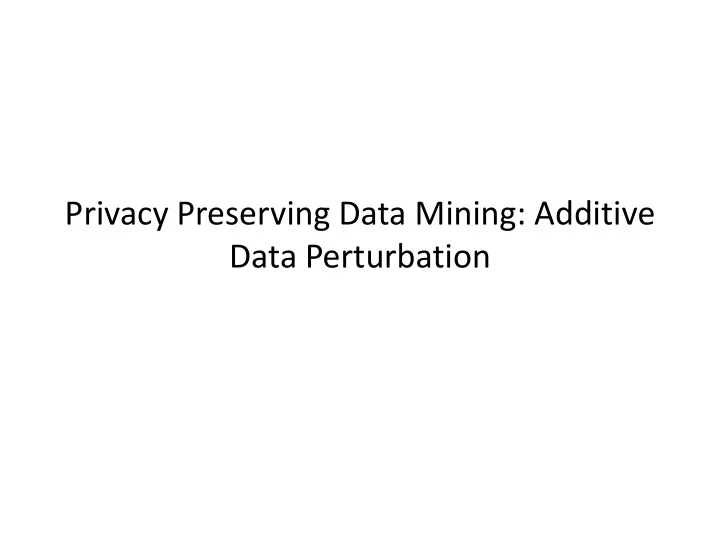

Privacy Preserving Data Mining: Additive Data Perturbation
Outline � Input perturbation techniques � Additive perturbation � Multiplicative perturbation � Privacy metrics � Privacy metrics � Summary
� Definition of dataset � Column by row table � Each row is a record, or a vector � Each column represents an attribute � Each column represents an attribute � We also call it multidimensional data 2 records in the 3-attribute dataset � � � A 3-dimensional record �� ��� ��� �� ��� ��
Additive perturbation � Definition � Z = X+Y � X is the original value, Y is random noise and Z is the perturbed value � Data Z and the parameters of Y are published � e.g., Y is Gaussian N(0,1) � History History � Used in statistical databases to protect sensitive attributes (late 80s to 90s) � Benefit � Allow distribution reconstruction � Allow individual user to do perturbation � Publish the noise distribution
Applications in data mining � Distribution reconstruction algorithms � Rakesh’s algorithm � Expectation-Maximization (EM) algorithm � Column-distribution based algorithms � Decision tree � Naïve Bayes classifier
Major issues � Privacy metrics � Distribution reconstruction algorithms � Metrics for loss of information � A tradeoff between loss of information and � A tradeoff between loss of information and privacy
Privacy metrics for additive perturbation � Variance/confidence based definition � Mutual information based definition
Variance/confidence based definition � Method � Based on attacker’s view: value estimation � Knowing perturbed data, and noise distribution � No other prior knowledge � Estimation method Confidence interval: the range having c% prob that the real value is in Perturbed value Y: zero mean, std σ Given Z, X is distant from Z in a range with c% conf
Problem with Var/conf metric � No knowledge about the original data is incorporated � Knowledge about the original data distribution � which will be discovered with distribution reconstruction, in additive perturbation reconstruction, in additive perturbation � can be known in prior in some applications � Other prior knowledge may introduce more types of attacks � Privacy evaluation need to incorporate these attacks
� Mutual information based method � incorporating the original data distribution � Concept: Uncertainty � entropy � Difficulty of estimation… the amount of privacy… � Difficulty of estimation… the amount of privacy… � Intuition: knowing the perturbed data Z and the noise Y distribution, how much uncertainty of X is reduced. � Z,Y do not help in estimate X � all uncertainty of X is preserved: privacy = 1 � Otherwise: 0<= privacy <1
� Definition of mutual information � Entropy: h(A) � evaluate uncertainty of A � Uniform distributions � highest entropy � Conditional entropy: h(A|B) � If we know the random variable B, how much is the � If we know the random variable B, how much is the uncertainty of A � If B is not independent of A, the uncertainty of A can be reduced, (B helps explain A) i.e., h(A|B) <h(A) � Mutual information I(A;B) = h(A)-h(A|B) � Evaluate the information brought by B in estimating A � Note: I(A;B) == I(B;A)
Distribution reconstruction � Problem: Z= X+Y � Know noise Y’s distribution Fy � Know the perturbed values z1, z2,…zn � Estimate the distribution Fx � Estimate the distribution Fx � Basic methods � Rakesh’s method � EM esitmation
Rakesh’s algorithm � Find distribution P(X|X+Y) � three key points to understand it � Bayes rule: � P(X|X+Y) = P(X+Y|X) P(X)/P(X+Y) � Conditional prob � Conditional prob � fx+y(X+Y=w|X=x) = fy(w-x) � Prob at the point a uses the average of all sample estimates
� The iterative algorithm Stop criterion: the difference between two consecutive fx estimates is small
Make it more efficient… � Bintize the range of x x � Discretize the previous formula m(x) mid-point of the bin that x is in Lt = length of interval t
Evaluating loss of information � The information that additive perturbation wants to preserve � Column distribution � First metric � First metric � Difference between the estimate and the original distribution
Evaluating loss of information � Indirect metric � Modeling quality � The accuracy of classifier, if used for classification modeling modeling � Evaluation method � Accuracy of the classifier trained on the original data � Accuracy of the classifier trained on the reconstructed distribution
DM with Additive Perturbation � Example: decision tree � A brief introduction to decision tree algorithm � There are many versions… � One version working on continuous attributes �
When to reconstruct distribution � Global – calculate once � By class – calculate once per class � Local – by class at each node � Empirical study shows � By class and Local are more effective
Summary � We discussed the basic methods with additive perturbation � Definition � Privacy metrics � Privacy metrics � Distribution reconstruction � The problem with privacy evaluation is not complete � Attacks
Recommend
More recommend